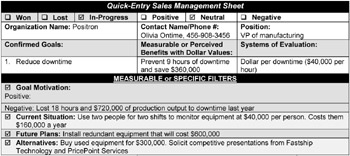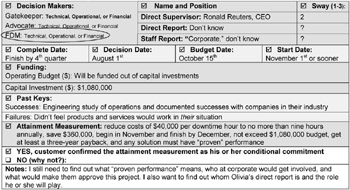Handling Selling Situations with Multiple Decision Makers
You probably have sales opportunities in which you need to find out information from different decision makers. And some situations arise in which different salespeople are working on the same sales opportunities. Each salesperson is probably at a different stage in the process. It is important that you coordinate your efforts and follow one simple rule: Make sure the salesperson dealing with the lowest-level decision maker conducts MP 2: Measure Potential first. Then, you can always verify the requirements of that person's conditional commitments with the next-highest-level decision maker before conducting MP 2 with that person. For instance, salesperson number one verifies MP 2 information gathered from a gatekeeper with salesperson number two before she starts her MP 2 phase with the advocate.
You want to ensure that you proceed with accurate information. You build momentum by not having to return to a previously completed MP because of inaccurate or incomplete data. Make sure all conditional commitments are accurate. Verify all previously established goals or filters with your contact before starting the third phase of MP 3: Cement Solution.
Regardless of how many salespeople are involved, only one proceeds with product selections to MP 3 and MP 4 with the final decision maker. With gatekeepers and advocates, you still go through all four MPs with them until you reach MPC 4: Agreement Confirmed. Their commitments will not be purchase orders. More likely, they are recommendations, endorsements, and arranged meetings with the FDMs. These agreed-upon MPCs and calls for action by the gatekeepers and advocates signal their support for you to the FDM. Furthermore, you get to use their MPC commitments whether they participate in your meetings with the FDMs or not.
| Note | Q sheets are especially valuable when there are various buying influences on the same sales opportunity. They record all the necessary information in one location. The more specific the information, the easier it is for you to determine a decision maker's authority and influence. |
To illustrate this point about different decision makers, Olivia, for this example only, is now the gatekeeper and advocate, not the final decision maker. Her role is to qualify suppliers' technical capabilities and then pass their proposals on to Ronald Reuters, the CEO.
Steven Smartsell completes MP 2: Measure Potential with Olivia Ontime. Steven's sales manager, Bobby Bigticket, is working with Ronald Reuters, the CEO of Positron, and the final decision maker. Steven makes sure his manager reviews a copy of his Q sheet with his MP 2: Measure Potential specifics and conditional commitment from Olivia before conducting MP 2 with the CEO to ensure consistency.
Bobby Bigticket will start his MP 2 meeting with the CEO by restating Olivia's conditional commitment he received from Steven to verify its accuracy.
Why Care If Customers Understand Their Purchasing Decisions?
You might be questioning the need to invest so much time and effort to ensure that customers understand their purchasing decisions. They are smart enough to know what they want on their own, right? It is easy to understand a mentality of "Who cares why customers make purchases as long as they buy from me.'' In both the short and long term, you care because sales are at stake.
You want your customers to buy for the right reasons. You do not want customers to feel their goals were not met. They should be able look back at any time and still be able to measure how your products met or exceeded their expectations. When customers can measure your achievements and their own, they act like long-term customers. Remember from the Introduction that the top-selling salespeople are the ones who have the most long-term customers. Additional sales become easy to obtain from long-term customers when you are in the relationship selling mode. In addition, documented and measurable successes become competitor-proof references to help you earn and win your next sale.
The following page shows how Steven fills out the front page of his Q sheet after completing MP 1 and MP 2 with Olivia. (See Exhibit 6-8.)


Exhibit 6-8: Quick-entry sales management sheet.
| Note | In this example, Olivia is the gatekeeper, advocate, and final decision maker. She is also the technical, operational, and financial person. If Steven met with her boss, Ronald Reuters, he would verify the data on a copy of this Q sheet to confirm the accuracy of Olivia's information. He would seek clarification on any differences, note them on Ronald's Q sheet, and then discuss them with Olivia. |
John Peters is a salesperson for Water Heaters Inc. He sells high-efficiency water heaters. Brian Walters is a homeowner who might need a water heater. John Peters will illustrate how to apply the steps of MP 1 and MP 2 in business-to-consumer transactions in which the salesperson must take the lead in suggesting the goals and SOEs. Most consumers are not as technically oriented as businesspeople. After all, their position as homeowner is not a technical one. So, salespeople must also use everyday terms. In addition, commercials and advertisements condition consumers to think in terms of perceived value, emotions, or low price, not measurable value and objective decision making. What a great opportunity for value-driven salespeople!
As you review John's Market Profile sheet in Exhibit 6-9 on page 182, you can see that John's product, the XLX 9000, has no unique strengths. Yet, John knows that his strongest features, sold collectively, can produce more value than those of competitors—if he can make them measurable. He also knows that in the replacement market he must use a SOE that can offset the costs of doing nothing (replacing an old water heater that still works for a so-called new and better one). His challenge is to find market segments whose goals can be achieved by those features.
| Market Segment: Replacement opportunities | ||||
| Market Segment Location: Homes on Elm, Oak, and Pine Streets | ||||
| Position: Owner, not renter | ||||
| Organizational Characteristics: Homeowners, houses built before 1971, greater than 2,200 square feet, family of five people or more a higher priority | ||||
| Previous Success Stories: More than 25 houses on these streets | ||||
| Homeowner's Goals | Homeowner's Benefits | Systems of Evaluation | XLX 9000 Features/Benefits | Unique Strengths |
| Reduce energy usage | Saves money | Kilowatts or therms (gas) used per BTU | High efficiency rating (lowers electrical or gas consumption) | No (MV) |
| Improve efficiency | Reduces reheat time | Minutes per reheat | Fast heat transfer (decreases downtime between showers) | No (MV) |
| Increases supply of hot water | Gallons of available hot water | Large water tank (stores more hot water than standard tanks | No (MV) | |
| Improve reliability | Minimizes inconvenience of no hot water | Number of moving parts | Solid-state design (reduces number of moving parts) | No (PV) |
| Reduce maintenance | Lowers repairs and maintenance costs | Unscheduled repair costs | 5-year parts and labor warranty | No (PV) |
Exhibit 6-9: Market profile sheet.
John identified Water Heater Replacement Opportunities as a market segment. He developed a modified-for-consumers Market Profile sheet for it by defining its organizational characteristics (in italics). His marketing logic for defining this market segment is as follows:
-
Homeowners. Renters are not interested in making investments in assets they do not own.
-
2,200-Square-Foot or Larger Houses. Larger homes usually house larger families. In addition, larger homes require larger water heaters and have higher utility costs to justify a reasonable payback (if necessary).
-
Built Before 1971. Oil embargoes were not in vogue yet, and therefore energy efficiency was not a major concern for American homeowners.
-
Families with Five or More Members. They require lots of hot water. (See Exhibit 6-9.)
As you review his Market Profile sheet, notice how the four organizational characteristics produce goals that match his features. How far you need to segment markets depends on the point at which you can link your strongest feature or unique strength. Sometimes, you need to consider your unique strengths at the company level not, just at the product level.
Thinking in terms of organizational characteristics, John also knows there are other reasons why people might increase their water-heating requirements. For instance, when people purchase Jacuzzis, they often increase their hot water requirements. Therefore, John would create a market segment for Jacuzzi owners. He might even want to offer Jacuzzi companies a commission on every sale that results from a lead they give him.
| Note | To simplify the case study, there is only one decision maker and only one of John's products, the XLX 9000, can satisfy Brian Walters's goals. In your selling situations, numerous products might help customers achieve their goals. The only requirement is that their features connect to the stated goals. In addition, all the benefits are internal because consumers do not have customers. |
EAN: 2147483647
Pages: 170
- Chapter I e-Search: A Conceptual Framework of Online Consumer Behavior
- Chapter VIII Personalization Systems and Their Deployment as Web Site Interface Design Decisions
- Chapter XI User Satisfaction with Web Portals: An Empirical Study
- Chapter XII Web Design and E-Commerce
- Chapter XVIII Web Systems Design, Litigation, and Online Consumer Behavior